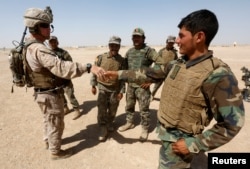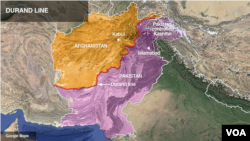After years of deriding the U.S. war in Afghanistan as a "complete waste," President Donald Trump on Monday is expected to explain why he now believes it is in the U.S. interest to remain committed to the South Asian country.
In an evening address from a military base outside Washington, Trump is likely to announce the deployment of several thousand additional U.S. troops to Afghanistan, as part of a wider shift in strategy, according to reports.
Trump’s decision follows a months-long policy review of the 16-year-old conflict, which has become the longest U.S. war ever.
WATCH: Related video report
Speaking Sunday, Defense Secretary Jim Mattis declined to comment on specifics, including troops levels, but said he was "very comfortable that the strategic process was sufficiently rigorous." Mattis also stressed the president’s plan involved more than just Afghanistan, saying it amounted to a full "South Asia strategy."
The State Department on Monday said Secretary of State Rex Tillerson had spoken over the phone with Pakistani Prime Minister Shahid Khaqan Abbasi, Indian Foreign Minister Sushma Swaraj and Afghan Foreign Minister Salahuddin Rabbani about how the United States would like to work with each country to stabilize South Asia through a new, integrated regional strategy.
The White House has said only that Trump's speech will lay out the "path forward" for Afghanistan.
U.S. generals have advised Trump to send several thousand more troops to break the stalemate and retake territory from the Taliban, which controls nearly half the country. But Trump, who campaigned on an "America First" foreign policy, has been reluctant to commit more resources to the country.
For years, Trump has criticized the U.S. effort in Afghanistan, calling it a "complete waste" and advocating a "speedy withdrawal" of U.S. troops so that the U.S. could spend more money "rebuilding" its own country.
Those comments could make it politically tricky for Trump, should he decide to make the case for an open-ended U.S. military commitment to Afghanistan. But just how Trump will define success in Afghanistan isn't clear.
James Dobbins, who served as U.S. Special Envoy for Afghanistan and Pakistan in 2013-2014, says Trump faces a choice between "losing and not losing."
"Winning is not an option," Dobbins told VOA's Afghan Service.
Trump's Afghanistan policy likely won't be drastically different from the existing strategy, says Wilson Center Asia program deputy director and South Asia senior associate Michael Kugelman.
"Though I imagine that could entail sending several thousand more troops to enhance the current U.S. training mission of the Afghan security forces," Kugelman said.
Additional U.S. troops could help train more members of the Afghan special forces, which have been overburdened, Kugelman told VOA. And he said the overall strategy will have to take into account neighboring Pakistan.
"It’s very hard to consider a way forward in Afghanistan without looking at the very connected case of Pakistan, which is a bordering country of Afghanistan and also happens to play a key role in the war in Afghanistan because, among other things, leaders of the Taliban insurgency have used Pakistan as a sanctuary," Kugelman said.
Afghanistan has been the subject of significant debate within the Trump administration. The president has been skeptical about a victory there.
"I want to find out why we’ve been there for 17 years," he told reporters at one point.
Call for strategy
In June, Mattis told a Senate panel: "We are not winning in Afghanistan."
The panel's chair, Arizona Republican John McCain, challenged Mattis on the subject. "We want a strategy, and I don’t think that’s a hell of a lot to ask," McCain said. "We’re now six months into this administration. We still haven’t got a strategy for Afghanistan. It makes it hard for us to support you when we don’t have a strategy."
The Pentagon has been awaiting a final decision by Trump on a proposal to send nearly 4,000 more U.S. troops to Afghanistan.
Currently, there are about 8,400 U.S. troops in Afghanistan. Most are advising Afghan forces, though some are tasked with carrying out counterterrorism operations against groups such as the Taliban or the Islamic State’s Afghan affiliate.
That number is down significantly from the height of former President Barack Obama’s troop surge, which saw nearly 100,000 U.S troops in Afghanistan in August 2010.
"Most Afghans are not expecting any fundamental change in U.S. policy," said Aimal Faizi, an Afghan journalist and aide to former President Hamid Karzai.
"Afghanistan has become a global issue. Any U.S. strategy based on the assumption that Washington alone decides the way forward in Afghanistan is a terrible mistake," he said.
Victor Beattie contributed to this report.











